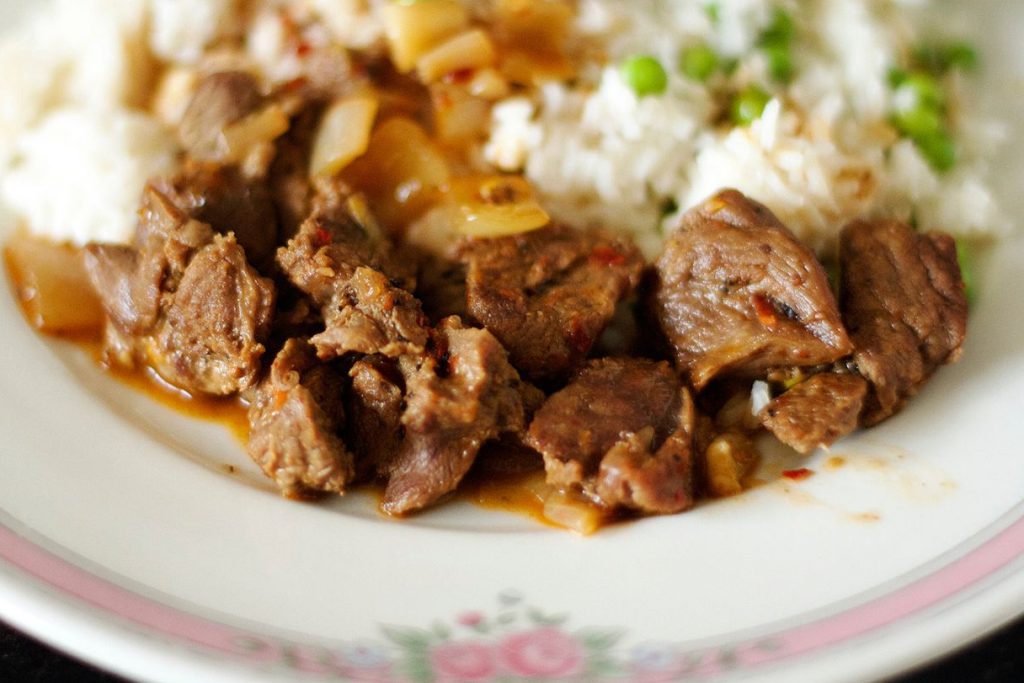People take supplements to improve or optimize their health. So what happens when you look at the label, and the ingredient list is filled with unrecognizable additives?
GABA Rice and What to Make With It
Beef, sweet potatoes, and rice are three natural sources of gamma-aminobutyric acid (GABA), the body’s calming neurotransmitter.
GABA rice is a particular form of sprouted brown rice that provides a more potent level of GABA. Specifically, germinated/sprouted brown rice provides 10 times the amount of GABA in white rice and two times the amount in regular brown rice [1]. It also contains less sugar and fewer calories than its milled counterparts [1].
You can buy GABA rice already sprouted at your local health food store or online, or you can sprout your own brown rice (described below). If you’re looking to maximize the benefits of GABA, we have a great serving suggestion: GABA rice with beef stew.
Beef, specifically, boosts the production and signaling of GABA by providing vitamin B-6, zinc, and the amino acids taurine and glutamine. If you prefer not to eat beef, for any reason, tofu is a great substitute, providing similar (although less abundant) nutrients.
This is a hearty and healthy meal that will ground and calm you as we wait for the winter weather to thaw into spring. What we love about a stew is the depth of flavor brought on by slow cooking means you can really taste all the ingredients, without a need for excessive flavoring or any added fat.

First, How to Make GABA Rice
Brown rice is different from white in that its hull is intact. This is necessary to germinate the grain/seed. If you are sprouting your own rice, be sure it is brown rice, and organic rice is always a superior option, eliminating additional toxins or chemicals that may prevent germination.
Rinse rice well and then put it in a shallow container (like a pyrex casserole dish). Cover the rice in dechlorinated water. Let the rice soak at room temp (in a warm room of your house if possible) for 24 hours [2]. If you can raise and maintain the temperature of rice up to 38°C (with a low-temp hot plate or fermentation device), the germination process and the associated increase in GABA can be sped up (down to 8 hours) [1]. Once the rice starts to sprout, drain the soaking liquid from the rice and cook it in fresh water.
You can use a rice cooker, a pressure cooker (instant pot), or the stovetop to cook sprouted GABA rice. If using a rice cooker or the stove top, there is much more evaporation than in a pressure cooker, so the liquid-to-rice ratios will differ. Use a 2:1 ratio of water to rice on the stove or rice cooker, and a 1:1 ratio of water to rice in the pressure cooker.
On the stove, add rice and cold water together in a pot. Place the pot over medium/high heat and bring it to a boil. Reduce to a simmer, covered, until water is absorbed.
In a pressure cooker, do not use the “rice” setting as it is designed for white rice. Set for 16 minutes and let the air vent naturally after cooking.
How Does GABA Work?
Gamma-aminobutyric acid (GABA) is a non-protein amino acid that is widely distributed in nature but is present in the highest concentrations in different brain regions of the brain [3]. GABA is the major inhibitory neurotransmitter in the mammalian central nervous system. This means it works in opposition to excitatory neurotransmitters, aiding in the relaxation and balancing the body’s responses to stress.
In the body, newly produced GABA is packaged into synaptic vesicles, released into the synaptic cleft, and emits its signal by binding 2 types of GABA receptors on the postsynaptic surface [3]. This binding and associated signal transmission promotes neuronal development and relaxation and can help to prevent sleeplessness and mood imbalance [3]. In fact, many anxiolytic pharmaceuticals (such as benzodiazepines) are designed to target these same GABA receptors.
Although there are GABA receptors throughout the body, the evidence on whether or not oral GABA supplements cross the blood-brain barrier efficiently is still heavily debated. This is why it is so important to also consume plentiful GABA precursors and receptor agonists, for intrinsic GABA production and signaling within the brain.
GABA Support Nutrients
Two such nutrients are the amino acids taurine and glutamine. Glutamine is both a precursor for GABA production and a conditionally essential amino aid. This means that in times of stress, the body isn’t able to produce enough glutamine for internal functions, and it becomes necessary to consume more of it from the diet. Taurine is a GABA receptor agonist, meaning it assists or amplifies GABA signaling when it binds receptors. Both of these amino acids can be taken as nutritional supplements and can be found in complete protein sources like beef and tofu.
Zinc, an essential mineral, also plays a role in the proper function of GABA receptors [4]. It follows that when zinc levels are low in the body, GABA signaling may fall ineffective.
Beef and Sweet Potato Stew Recipe
Ingredients
3 tablespoons all-purpose flour (or 1-to-1 gluten-free flour)
2 teaspoons ground cumin
1 bay leaf
1 teaspoon salt
1/4 teaspoon cayenne pepper
2 pounds beef stew meat or chuck, cut into cubes
3 cups of peeled and cubed sweet potatoes
1 medium onion, roughly chopped
3 cloves of garlic, finely chopped
1 can (410 grams) diced tomatoes
2 cups of broth (beef, chicken, or vegetable)
2 tablespoons red wine vinegar
Chopped parsley for serving (optional)
Stove Top Instructions
- Heat a dutch oven over medium heat.
- In a shallow dish, mix the flour, salt, cumin, and cayenne together. Coat beef cubes well in flour mixture.
- Brown the beef cubes in the pot, removing them when seared on all sides. Brown them in batches so as to not overcrowd.
- Set beef aside and add the onions to the pot. Once translucent, add garlic and continue to cook, stirring frequently, until garlic is fragrant.
- Add vinegar to the pot and scrape brown bits from the bottom before adding broth, tomatoes, bay leaf, and beef cubes back in.
- Stir together and bring to a boil. Once boiling, reduce to a simmer, cover, and cook until beef is tender (about 1.5 hours).
- Add the sweet potatoes and continue simmering until they are tender (about 30 more mins). If needed, add more water or broth so sweet potatoes are immersed.
- If you are serving over GABA rice, we suggest starting rice prep after adding sweet potatoes to the stew.
- Remove bay leaf before serving ladled stew over hot GABA rice. Sprinkle individual servings with chopped parsley, if desired.
Slow Cooker Instructions
- Follow the instructions above through step 3.
- Add the remaining flour mixture to the bottom of your slow cooker. Add the seared beef, then the remainder of the ingredients, finishing with sweet potatoes.
- Set the slow cooker to high and cook for 4-6 hours, or on low for 8-9 hours.
- Patil, Swati Bhauso, and Md Khalid Khan. “Germinated brown rice as a value added rice product: A review.” Journal of food science and technology 48 (2011): 661-667.
- Liang, Jianfen, et al. “Effects of soaking, germination and fermentation on phytic acid, total and in vitro soluble zinc in brown rice.” Food chemistry 110.4 (2008): 821-828.
- Ngo, Dai-Hung, and Thanh Sang Vo. “An updated review on pharmaceutical properties of gamma-aminobutyric acid.” Molecules 24.15 (2019): 2678.
- Hosie, Alastair M., et al. “Zinc-mediated inhibition of GABAA receptors: discrete binding sites underlie subtype specificity.” Nature neuroscience 6.4 (2003): 362-369.
Share:
Related Posts

Goodbye Pie Chart, Hello Phase 1 Sliders
Written by Allison Smith, ND | 2025 As we usher in a new era of DUTCH testing which leaves behind the concept of the three-way

Introducing the DUTCH Dozen
Written by Kelly Ruef, ND | 2025 Hormone testing can be complex, which is why Precision Analytical developed the DUTCH Dozen, an interpretive framework that

DUTCH Report Enhancements
Written by Hilary Miller, ND | 2025 Precision Analytical have released the newest version of the DUTCH Test. This is the report’s most significant update

Gallbladder Health 101: What It Does and How to Keep It Working Well
Written by Ashley Palmer & Pooja Mahtani | 2025 The gallbladder may not get much attention compared to the gut, but it plays a central

Can You Bring Vitamins on a Plane? How To Travel with Supplements
Written by Austin Ruff | 2024 Are you traveling for a work conference, an athletic competition, or a weekend getaway? Just because you’re leaving home

